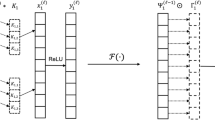Abstract
Based on the classification ability of a convolutional neural network (CNN), this paper proposes a structural damage detection method in which a CNN is used to classify the location and level of damage in a structure. The dynamic responses are combined with the modal parameters of the structure as the inputs to the CNN to detect the damage. As structure damage can cause changes in multiple damage indicators, an individual indicator may not be enough to detect all damage scenarios. The combination of multiple damage indicators will provide more comprehensive information for damage situation. It is expected that this combination will overcome disadvantages of the damage index based on a single modal parameter. The finite element method was used to provide the training samples for the network. Damage in an element was introduced by reducing its Young’s modulus. Two cases were considered for the input of the CNN: the first used the modal strain energy only, and the second used the combination of modal strain energy and dynamic response (acceleration). The comparison results show that the inclusion of dynamic responses in the damage index significantly improves the correctness rate of structural damage detection and enhance the convergence of the network.










Similar content being viewed by others
References
Doebling SW, Farrar CR, Prime MB (1998) A summary review of vibration-based damage identification methods. Shock Vib Dig 30(2):91–105
Worden K, Farrar CR, Manson G, Park G (2007) The fundamental axioms of structural health monitoring. Proc R Soc A Math Phys Eng Sci 463(2082):1639–1664
Farrar CR, Doebling SW (2001) Vibration-based structural damage identification. Philos Trans R Soc Lond A 359:131–149
Adewuyi AP, Wu Z (2009) Assessment of vibration-based damage identification methods using displacement and distributed strain measurements. Struct Health Monit 8(6):443–461
Wu S, Zhou J (2016) Reformulation of elemental modal strain energy method based on strain modes for structural damage detection. Adv Struct Eng 20(6):896–905. https://doi.org/10.1177/1369433216665626
Cawley P, Adama RD (1979) The location of defects in structures from measurements of natural frequencies. J Strain Anal Eng Des 14(2):41–51
Pandey AK, Biswas M, Samman MM (1991) Damage detection from changes in curvature mode shapes. J Sound Vib 145(2):321–332
Alvandi A, Cremona C (2006) Assessment of vibration-based damage identification techniques. J Sound Vib 292(1):179–202
Chen Y, Hou XB (2016) Applications of different criteria in structural damage identification based on natural frequency and static displacement. Sci China Technol Sci 59(11):1746–1758
Lofrano E, Paolone A, Romeo F (2014) Damage identification in a parabolic arch through the combined use of modal properties and empirical mode decomposition. In: Proceedings of the 9th international conference on structural dynamics, Porto, Portugal, pp 2643–2650
Geng X, Lu S (2018) Research on FBG-based CFRP structural damage identification using BP neural network. Photonic Sens 8(2):1–8
Hadi S, Saptarshi D (2018) Structural damage identification using image-based pattern recognition on event-based binary data generated from self-powered sensor networks. Struct Control Health Monit 25(1):e2135
Zang C, Imregun M (2001) Structural damage detection using artificial neural networks and measured FRF data reduced via principal component projection. J Sound Vib 424(5):813–827
Adeli H (2001) Neural networks in civil engineering: 1989–2000. Comput Aided Civ Infrastruct Eng 16:126–142
Adeli H, Hung ST (1995) Machine learning-neural networks, genetic algorithms and fuzzy systems. Kybernetes 28(3):317–318
Lee JJ, Lee JW (2005) Neural networks-based damage detection for bridges considering errors in baseline finite element models. J Sound Vib 280(3):555–578
Wu X, Ghaboussi J (1992) Use of neural networks in detection of structural damage. Comput Struct 42(11):578–581
Pattanayak S (2017) Convolutional neural networks. Pro Deep Learning with TensorFlow, Bangalore
Baneen U, Kinkaid NM (2012) Vibration based damage detection of a beam-type structure using noise suppression method. J Sound Vib 331(8):1777–1788
Cha YJ, Choi W (2017) Deep learning-based crack damage detection using convolutional neural networks. Comput Aided Civ Infrastruct Eng 32(5):361–378
Lin YZ, Nie ZH (2017) Structural damage detection with automatic feature-extraction through deep learning. Comput Aided Civ Infrastruct Eng 00(6):1–22
Gulgec NS, Takáč M, Pakzad SN (2019) Convolutional neural network approach for robust structural damage detection and localization. J Comput Civ Eng 33(3):04019005
Krizhevsky A, Hinton G (2009) Learning multiple layers of features from tiny images. Technical report, University of Toronto
Shi ZY, Law SS, Zhang LM (2000) Structural damage localization from modal strain energy change. J Eng Mech 218(5):1216–1223
Scherer D, Muller A, Behnke S (2010) Evaluation of pooling operations in convolutional architectures for object recognition. In: International conference on artificial neural networks
Min W, Liu B, Foroosh H (2018) Look-up table unit activation function for deep convolutional neural networks. In: IEEE winter conference on applications of computer vision
Nair V, Hinton GE (2010) Rectified linear units improve restricted Boltzmann machines. In: International conference on international conference on machine learning
Krizhevsky A, Sutskever I (2012) Imagenet classification with deep convolutional neural networks. In: International conference on neural information processing systems
Lawrence S, Giles CL, Tsoi AC, Back AD (1997) Face recognition: a convolutional neural-network approach. IEEE Trans Neural Networks 8(1):98–113
Prasoon A, Petersen K, Igel C, Lauze F, Dam E, Nielsen M (2013) Deep feature learning for knee cartilage segmentation using a triplanar convolutional neural network. In: International conference on medical image computing and computer-assisted intervention, pp 246–253
Acknowledgements
This research was partially supported by the project (No. 31470908) of the National Natural Science Foundation of China.
Author information
Authors and Affiliations
Corresponding author
Additional information
Publisher's Note
Springer Nature remains neutral with regard to jurisdictional claims in published maps and institutional affiliations.
Appendix
Rights and permissions
About this article
Cite this article
Teng, S., Chen, G., Gong, P. et al. Structural damage detection using convolutional neural networks combining strain energy and dynamic response. Meccanica 55, 945–959 (2020). https://doi.org/10.1007/s11012-019-01052-w
Received:
Accepted:
Published:
Issue Date:
DOI: https://doi.org/10.1007/s11012-019-01052-w




